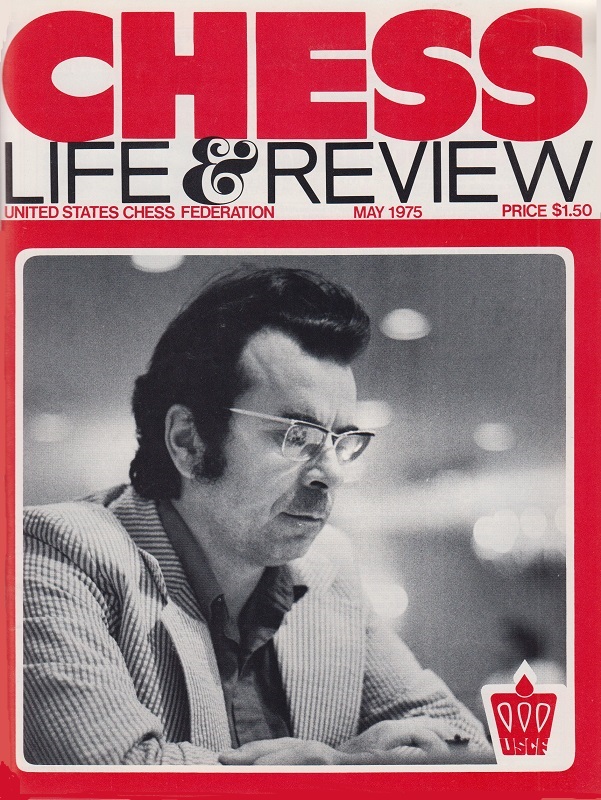
Edward Winter

Pal Benko
Pages 410-413 of the August 1978 Chess Life & Review carried an excellent interview by Pal Benko with Max Euwe on the occasion of the latter’s 77th birthday. For Euwe’s comment about his only problem composition, see pages 41-42 of Kings, Commoners and Knaves. Some remarks by him about the 1935 world championship match were quoted in C.N. 3005 and are given in Alekhine and Alcohol.
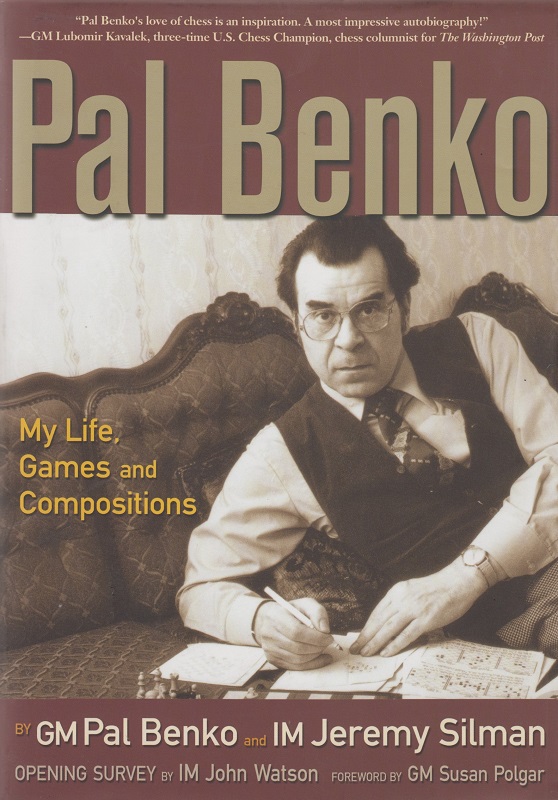
From Avital Pilpel (New York):
‘In Pal Benko My Life, Games and Compositions by Benko and Jeremy Silman (Los Angeles, 2003) Silman interviews various chess personalities who knew (and know) Benko, and Benko himself. Many of the answers deal with unverifiable private matters, but some make claims about specific chess events which it may be possible to verify or disprove.
Page 414: Ronald Gross about Bent Larsen: “Larsen... spoke 13 languages fluently”. Is this intended literally? If so, which languages?
Page 418: Ronald Gross commenting on a 1963 Piatigorsky Cup tournament game between Reshevsky and Benko:
“The assistant tournament director who was in charge of that game was Jack Moskowitz (an old time friend of Sammy’s), and Benko was winning or drawing the game. Reshevsky’s flag went down on the 38th move and the instructions were very clear: it was not up to the players to claim, it was up to the director. I saw the flag drop, but Benko was low on time and wasn’t looking at the clock. Then I looked at Jack’s face and watched him stare directly into the clock. He saw that Reshevsky had forfeited. Incredibly, he didn’t say anything. After the 38th move was played by Benko, I still thought he’d notice Reshevsky’s fallen flag on the 39th (Reshevsky was very aware that his flag had fallen), but Jack still kept quiet.”
Is there independent evidence of this?
Page 642: A helpmate in three composed by Benko:
It “left Botvinnik, Keres and Geller baffled” (page 639) and “baffled many strong players” (page 642). Page 419 quotes Gross, presumably about the same problem: “It turned out to be one of his most successful helpmate problems, and players such as Botvinnik, Keres and Geller were not able to solve it.” Is there more information about the circumstances when these masters were shown the problem and of their failure to solve it? It was first published in the Berliner Morgenpost in 1970, according to the book (page 642).’
As regards the Reshevsky v Benko game (1 c4 Nf6 2 d4 g6 3 g3 Bg7 4 Bg2 c5 5 d5 d6 6 Nc3 a6 7 a4 O-O 8 Nf3 e5 9 O-O Ne8 10 e4 Bg4 11 Qb3 Bxf3 12 Bxf3 Nd7 13 Bg2 a5 14 Nb5 Ra6 15 Bd2 Nc7 16 Ra3 Nxb5 17 Qxb5 Ra7 18 Bh3 Nf6 19 f3 Qc7 20 Rb3 Rfa8 21 Qb6 Qxb6 22 Rxb6 Bf8 23 Ra1 Be7 24 Ra3 Bd8 25 Rxd6 Ne8 26 Rd7 Nf6 27 Rd6 Ne8 28 Rd7 Nf6 29 Rxd8+ Rxd8 30 Bc3 Nd7 31 Rb3 f6 32 Rb5 Kf7 33 b3 Ke7 34 Bxa5 b6 35 Bxb6 Nxb6 36 Rxb6 Rd6 37 Rb5 Rc7 38 Kf2 Ra6 39 Ke3 Kd6 40 Kd3 Rca7 41 Bc8 Resigns), the photograph below appeared on page 255 of Chess Review, August 1963:
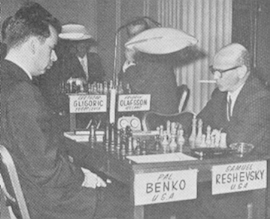
We note, in particular, that page 167 of the July-August 1963 Chess Life had, from Isaac Kashdan, a quite different account of what happened:
‘In this game too the time-limit was vital. In fact it was the subject of the first claim that required the director’s decision.
Reshevsky obtained a clear advantage in the opening. His queen and rooks marched in on the queen side, where he commenced an attack against the vulnerable black pawns.
Benko found what seemed a neat resource, giving up a pawn to trap Reshevsky’s rook. Reshevsky took a long look, walked into the situation, and after repeating moves a couple of times, gave up the rook for Benko’s bishop.
In a few moves Reshevsky justified the sacrifice when he captured two of Benko’s pawns in succession, giving him material superiority for the first time. But all this took time, and he had only seconds left.
Reshevsky made his 40th move, with the flag on his clock on the brink, but still in the up position. Benko moved immediately, pressed the lever, and Reshevsky’s flag dropped. He promptly claimed the game on a time forfeit.
Assistant directors Harry Borochow and Jack Moskowitz were on top of the play and agreed that Reshevsky was safe. Actually, if Benko wished to make a claim, he should have done so before making his own 40th move. The rules state clearly that a player cannot make any claim unless he is on the move.
A later discussion indicated that Benko had miscounted the moves and thought that only 39 had been made by both players.
When things quieted down, Reshevsky sealed his 41st move. The game was resumed at 1 p.m. Friday and Reshevsky scored the point. A second or two made the difference between winning and losing. It is all in the life of a grandmaster.’
(3933)
Michael McDowell (Westcliff-on-sea, England) offers some observations on problem compositions in Pal Benko My Life, Games and Compositions by Benko and Jeremy Silman (Los Angeles, 2003):
- ‘Page 570 No. 5. The comment is incorrect. There are eight promotions but only four mates: 1...c1(Q)/cxd1(N) 2 Qxe2; 1...c1(N)/cxd1(Q) 2 Qb4; 1...exd1(Q)/e1(N) 2 Qe3; 1...exd1(N)/e1(Q) 2 Rxc2.
- Page 571 No. 7. The comment on page 569 referring to this problem is rather odd, as Mansfield had combined white and black organ pipes in the following problem: Comins Mansfield, 1st Honourable Mention, The Problemist, 1961. 4Q3/2Kp1p2/1P1N1P1b/p2k3r/P3p2r/P3p2r/n3p2b/4P3/BRRB1N2 #2. In both problems there are mates prepared for all black moves in the diagram. Benko’s key simply maintains the Zugzwang, whereas Mansfield’s key 1 Rb3 changes the mate for 1…N(x)b1 from 2 Bb3 to 2 Rb5. Mansfield’s setting, however, suffers from the severe defect that the d1 bishop is useless after the key, and the problem is sound without it. Benko’s is much the better problem.
- Page 578 No. 42. Anticipated by Michael Lipton, Jerusalem Post, 1960. R7/B7/B7/16/2p4r/8/k1K5 #2. 1 Bb6.
- Page 587 No. 74. Anticipated by W.A. Shinkman, Tiffin Tribune, around 1898 (source as given on page 82 of The Golden Argosy) 8/7p/8/7k/5K2/8/6R1/8 #3. 1 Rg1 h6 2 Rg2.
- Page 588 No. 80. The manoeuvre was shown by J. Jespersen, Vor Tid, 1883. 16/1K6/8/k7/8/1R6/8 #6. 1 Rb5 2 Ka5 3 Ka4 4 Kb3 5 Rc5.
- Page 648 No. 267. Incorrect source. Published as an original in The Problemist, July 1976.’
(4022)
From page 426 of the Benko/Silman book:
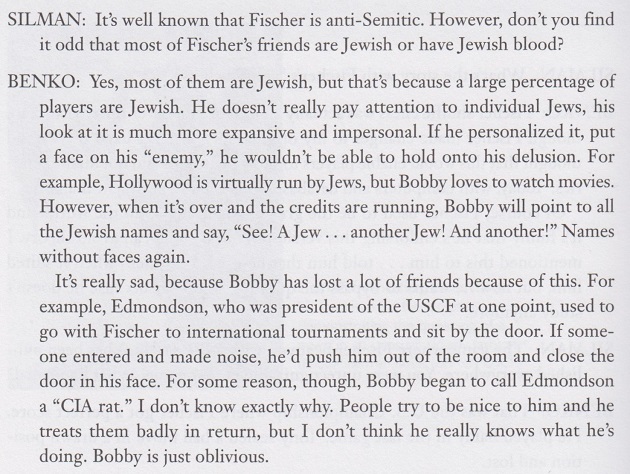
Concerning Fischer’s virulent anti-Semitism, see too A Letter from Bobby Fischer to Pal Benko and Brad Darrach and the Dark Side of Bobby Fischer.
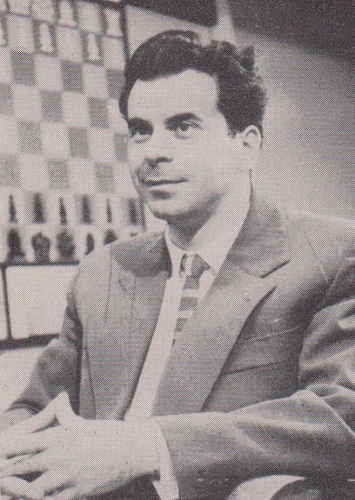
Pal Benko, Chess Review, December 1959, page 361 and June 1961, page 165
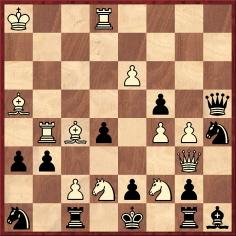
Mate in three
This problem appeared with the reference ‘A. Ancin, Czechoslovakia’ on page 275 of the May 1971 Chess Life & Review, in the ‘Benko’s Bafflers’ column. The key move is 1 Nf1, and Pal Benko gave the full solution on page 315 of the June 1971 Chess Life & Review.
The composition was subsequently taken up in ‘Larry Evans on Chess’ on page 647 of the November 1971 issue. That item is reproduced here without comment:
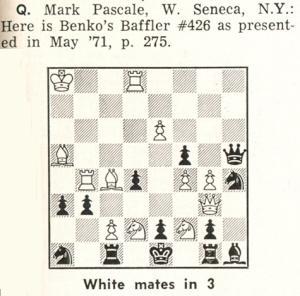
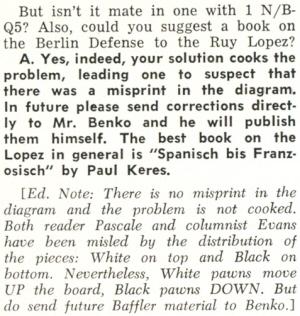
(7229)
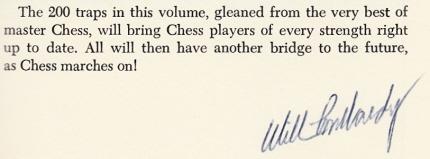
Above, at the end of his Preface, is William Lombardy’s signature in our copy of Modern Chess Opening Traps (C.N. 8718), which was later published in the United Kingdom by B.T. Batsford Ltd. under the title Snatched Opportunities on the Chessboard.
In most of the 200 games the players’ names are omitted, but an exception, on pages 304-308, is Lombardy’s ‘mini-delayed brilliancy’ against Benko, introduced as follows:
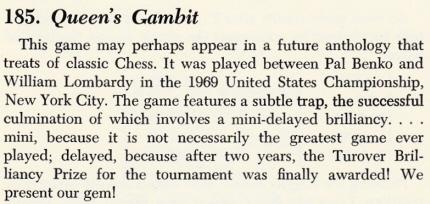
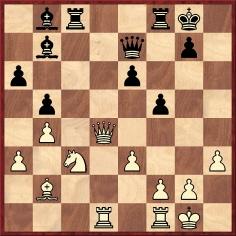
Position before 22...Bf3.
Even this notable game is mishandled by some databases (‘USA, 1970’). It was played on 14 December 1969, in the ninth round of the US Championship in New York, as shown in a table on page 9 of Morton Siegel’s tournament book.
From pages 52-53 of that work:
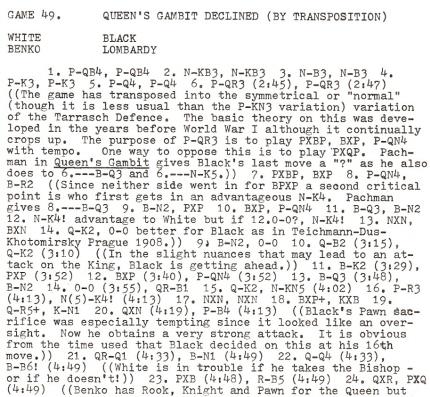
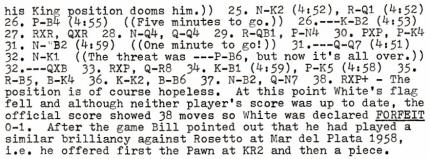
Regarding clock times, page 6 gave this explanation:
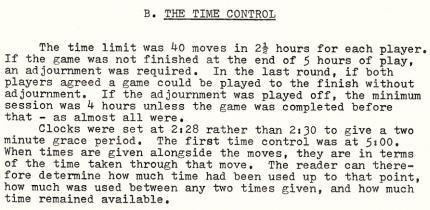
Lombardy annotated the game on pages 211-213 of Understanding Chess. My System, My Games, My Life (New York, 2011).
(8719)
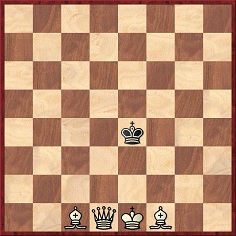
Mate in three
This composition has been widely published, e.g. on page 246 of Miniature Chess Problems From Many Countries by Colin Russ (London, 1981).
Russ gave it with a correct citation, ‘P. Benko, Chess Life, 1968’. From page 304 of the August 1968 Chess Life, on the second page of an article by Benko entitled ‘Echo and Repetition’:
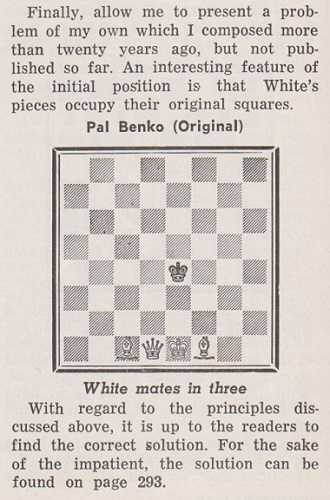
The solution on page 293:
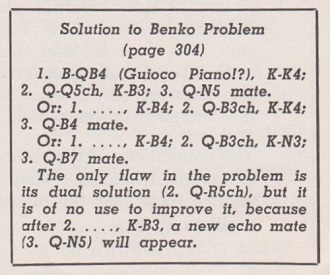
Benko also published the problem on other occasions, e.g. on page 233 of the April 1977 Chess Life & Review.
In an article dated 22 August 2005 on pages 38-39 of his dire book This Crazy World of Chess (New York, 2007) Larry Evans put the black king on e5 (a change which, curiously, does not affect the key move) and wrote:
‘Bobby Fischer once bet he could solve it in a half hour and lost. ... Bobby then bet Benko he could find a second solution (called a cook) if he could study it overnight. He lost again. There is one and only one key move.’
No source or other information was given, the word ‘once’ being
deemed sufficient. The same diagram and text appeared on pages
41-42 of the ‘new edition’ (Las Vegas, 2009).
On pages 581-582 of Pal Benko My Life, Games and Compositions by P. Benko and J. Silman (Los Angeles, 2003) Benko wrote that it was ...
‘... the last problem I composed as a teenager. It was published many times because its original setup appealed to problem-solvers and tournament players alike.
During the Lugano Olympiad, which Bobby Fischer attended as a spectator, I made a bet with him that he couldn’t solve it in 30 minutes. As time ran out, he became irritated and demanded to see the answer. When I showed it to him, he insisted that other solutions had to exist. Naturally, this led to another bet. After more time passed, he was forced to settle both wagers. The teenage Pal Benko never would have guessed how much mileage he was going to get out of that little problem.’
In a ChessBase article dated 5 September 2011, in which Benko stated that he composed the problem when aged 15, the Fischer story at the Lugano Olympiad was related again.
It should, though, be noted that the Lugano Olympiad took place in October-November 1968 and that, as shown above, Benko had already published the problem in the August 1968 Chess Life.
A sidelight is that page 582 of Benko’s book added:
‘M. Grigoriev imitated this problem by placing Black’s king on b4. He published it in 64 in 1982, claiming a mate in two by 1 Qd5. Unfortunately, he overlooked the cook 1 Qd4+.’
An inscription by Benko on page 47 of our copy of Kandidatenturnier für Schachweltmeisterschaft by S. Gligorić and V. Ragozin (Belgrade, 1960):
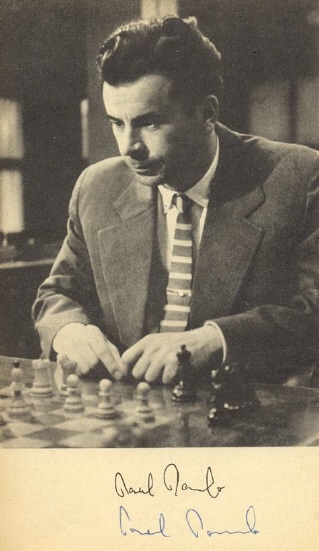
(9043)
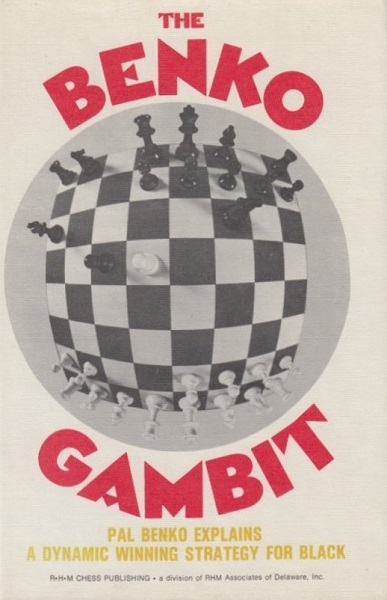
From page 7 of The Benko Gambit by P. Benko (New York, 1973):
‘It is hardly possible to state precisely who first adopted the gambit. Some Swedish sources mention that it first occurred there in the 1920s and that tournaments especially for the gambit were organized later. The three internationally known masters of Sweden’s past – Ståhlberg, Stoltz and Lundin – also used it, although Ståhlberg found it not to his taste either as White or as Black. Indeed, the Swedish players appear to have used the king’s-side fianchetto, if not the modern order of moves. Of course, the gambit may have occurred elsewhere as well, but it was undoubtedly Lundin who introduced it into international tournament practice. Nevertheless, it later fell into oblivion.
The earliest examples of the gambit in serious competition are the games Bronstein-Lundin [1948], Szabó-Lundin [1948] and Taimanov-Bronstein [1953] ...’
And from page 9 of Benko Counter-Gambit by D. Levy (London, 1978):
‘It is hardly possible to determine exactly when any particular chess opening or variation was played for the very first time, and so it is with the Benko Gambit. It seems most likely that the gambit was born in Sweden during the 1920s and it was the Swedish duo Lundin and Stoltz and the Czech master Opočenský who introduced it in international competition.’
What is known about any such Swedish games from the 1920s?
In passing we add that Levy’s book (page 100) mentions a game ‘Ståhlberg – Stoltz, Sweden, 1933’ which began 1 d4 Nf6 2 c4 c5 3 d5 b5 4 cxb5 Bb7. It may be recalled that Rubinstein v Spielmann, Vienna, 1922 opened 1 d4 Nf6 2 Nf3 c5 3 d5 b5 4 c4 Bb7 and that against Tarrasch in the Pistyan tournament earlier the same year Alekhine played, as Black, 1 d4 Nf6 2 Nf3 e6 3 c4 c5 4 d5 b5 (the Blumenfeld Counter-Gambit). Goldstein v Wilson, Hampstead, 1924 opened 1 d4 Nf6 2 c4 e6 3 Nc3 c5 4 d5 b5 (BCM, December 1924, pages 483-484).
Benko’s book (page 1) notes that ‘the usual starting position of the so-called Benko Gambit’ comes after 1 d4 Nf6 2 c4 c5 3 d5 b5 4 cxb5 a6 5 bxa6 Bxa6. See also pages 233-234 of Pal Benko My Life, Games and Compositions by Benko and Jeremy Silman (Los Angeles, 2003).

Inscription by Benko in his Benko Gambit book
(3957)
From Calle Erlandsson (Lund, Sweden):
Mr Erlandsson, who provided the above translation, adds:‘In the preface (pages 4-7) to the booklet Volga-gambit by J. Berglund and H. Åkvist (second edition, Stockholm, 1971) there is an historical survey of the opening (1 d4 Nf6 2 c4 c5 3 d5 b5). The following is of particular interest:
“In Sweden the Volga Gambit turned up at the end of the 1920s. According to Fritz Kaijser (Vällingby SS), who over the years has been regarded as the Swedish expert in this area, there was an old teacher of our grandmaster Gösta Stoltz, named Dahlqvist, who started playing the Volga Gambit in Sweden. Not much attention was paid to the variation until [Bruno] Dahlin, a newspaper assistant to the international master Erik Lundin, frequently played the variation during the Stockholm city championship at the end of the 1920s. Whether he, in turn, had obtained the idea from Dahlqvist is not known. Dahlin was not just anybody. His playing strength was so good that he had been Stockholm city champion.
One of Dahlin’s earliest opponents with this opening was Fritz Kaijser himself. Kaijser was curious about the opening and later he introduced it to his colleagues. There were four players who were together and trained at chess: Gideon Ståhlberg, Gösta Stoltz, Stig Lundholm and Kaijser. The training was organized in such a way that thematic tournaments were played. Once there was an idea of making a compilation of the thematic tournaments. Lundholm was the first victim who compiled material on his opening. Kaijser was the next. But harder times came with the Second World War. Chess was not the first priority, so the Volga Gambit, which was Kaijser’s department, was never finished. We therefore never had the chance to see how the ideas developed over the years. According to his own statement, the move 4…a6 did not occur at the outset, but was an improvement by Kaijser.”’
‘Fritz Kaijser was born in Härnösand (northern Sweden) on 13 August 1908 and died in Stockholm on his 75th birthday. He became a Professor of public law in 1964 and was promoted to doctor honoris causa at Stockholm University. He was a reserve at the so-called Olympiad in Munich in 1936 and achieved 6/10 (+4 –2 =4 ). An obituary was published in Tidskrift för Schack, September 1983, pages 232-233.’
(3967)
Gerd Entrup (Herne, Germany) raises the wider question of the earliest occurrence in play of the general ideas behind the Benko Gambit (not necessarily in the first few moves). He proposes Marshall v Réti, New York, 1924, which was annotated on pages 37-40 of Alekhine’s book Das Grossmeister-Turnier New York 1924 (Berlin and Leipzig, 1925) and on pages 18-20 of the English translation.
The game began 1 d4 Nf6 2 Nf3 g6 3 c4 Bg7 4 Nc3 O-O 5 e4 d6 6 Bd3 Bg4 7 h3 Bxf3 8 Qxf3 Nfd7 9 Be3 c5 10 d5 Ne5 11 Qe2 Nxd3+ 12 Qxd3 Nd7 13 O-O Qa5 14 Bd2 a6 15 Nd1 Qc7 16 Bc3
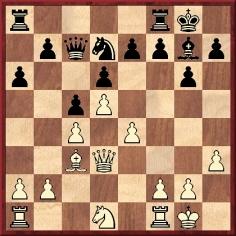
Réti played 16...Ne5, and Alekhine wrote: ‘Bereitet das folgende allzu kühne Bauernopfer vor – im Bestreben, gewaltsam remis zu vermeiden.’ [‘Preparing for the subsequent over-daring sacrifice of the pawn with the intention of avoiding a forced draw.’]
After 17 Qe2 b5 Alekhine commented:
‘Diesen Bauern konnte Weiß ruhig nehmen, da Schwarz Schwierigkeit gehabt hätte, dafür positionellen Ersatz zu erlangen, z.B. 18 c4-b5: a6-b5: 19 De2-b5:! c5-c4 (offenbar die beabsichtigte Pointe des Bauernopfers) 20 Lc3-e5: Lg7-e5: (oder 20...Tf8-b8 21 Db5-c6 Dc7-c6: 22 d5-c6: Lg7-e5: 23 Ta1-c1 Le5-b2: 24 Tc1-c4: mit Vorteil, da Schwarz den a-Bauern wegen 25 Tc4-c2 usw. nicht nehmen darf) 21 Sd1-e3 c4-c3 22 b2-c3: Dc7-c3: 23 Ta1-c1 und Weiß hätte zum mindesten ein sehr leichtes Remis gehabt. Nach der Ablehnung des Opfers wird er dagegen erst hart kämpfen müssen, um es zu erreichen.’ [‘White could safely have captured this pawn, as Black would have difficulty in obtaining positional compensation, for instance: 18 PxP PxP 19 QxP P-B5 (clearly the reason for the pawn sacrifice) 20 BxKt BxB (or 20...KR-Kt 21 Q-B6 QxQ 22 PxQ BxB 23 QR-B BxP 24 RxP with advantage, as Black dare not capture the QR pawn, on account of 25 R-B2) 21 Kt-K3 P-B6 22 PxP QxP 23 QR-B, and White would have had at least a very easy draw. After the refusal of the sacrifice, on the other hand, he can now reach that goal only after hard fighting.’]
The game continued 18 cxb5 axb5 19 f4 Nc4 20 Bxg7 Kxg7 and was drawn at move 50.
(5457)
Further to C.N. 5457, Tim Bogan (Chicago, IL, USA) comments that if ‘general ideas’ is taken to mean that Black sacrifices a queen’s-side pawn for pressure on the opened files, the game Nimzowitsch v Capablanca, St Petersburg, 1914 may be regarded as an early model.
We add that Alekhine made a similar point about that game (describing it as ‘sensational’) in his notes to van Scheltinga v Opočenský, Buenos Aires, 1939. See pages 165-167 of Gran Ajedrez (Madrid, 1947) and pages 200-202 of 107 Great Chess Battles (Oxford, 1980).
(5461)
Further to a correspondent’s remark in C.N. 5461 that Black’s sacrifice of a queen’s-side pawn for pressure on the opened files occurred in Nimzowitsch v Capablanca, St Petersburg, 1914, Gerd Entrup (Herne, Germany) points out the game Viakhirev v Romanovsky, as annotated on pages xxvi-xxvii of Emanuel Lasker’s Der internationale Schachkongress zu St. Petersburg 1909 (Berlin, 1909):
1 e4 e5 2 Nc3 Nf6 3 Bc4 Bc5 4 d3 d6 5 f4 Nc6 6 f5 (‘Schwarz hat nun ein schwieriges Problem zu lösen. Wie soll er dem drohenden Lc1-g5 begegnen und zugleich das ihn einschnürende Zentrum sprengen? Wäre d6-d5 möglich, so bestände keine Gefahr; aber Weiß hat den Punkt mehr als ausreichend gesichert.’) 6...Na5 7 Qf3 Nxc4 8 dxc4 c6 9 Bg5
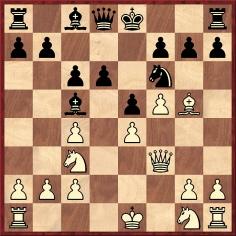
9...b5 (‘Schwarz löst die Aufgabe in mutiger Weise. Er opfert zwei Bauern, um an den schwachen Punkt des Gegners, e4, gelangen zu können.’) 10 cxb5 Qa5 11 bxc6 Rb8 12 Bd2 (‘Wenn 12 Ta1-b1 Sf6xe4 13 Df3xe4 Tb8xb2.’) 12...Qb6 (‘Sehr gut. Wenn nun 13 Sc3-a4 Dxc6 14 Sxc5 Dxc5. Schwarz bedroht neben dem c- und b-Bauern auch e4 durch Lb7.’) 13 Nge2 Qxc6 14 b3 Bb7 and Black eventually won (at move 43).
(7791)
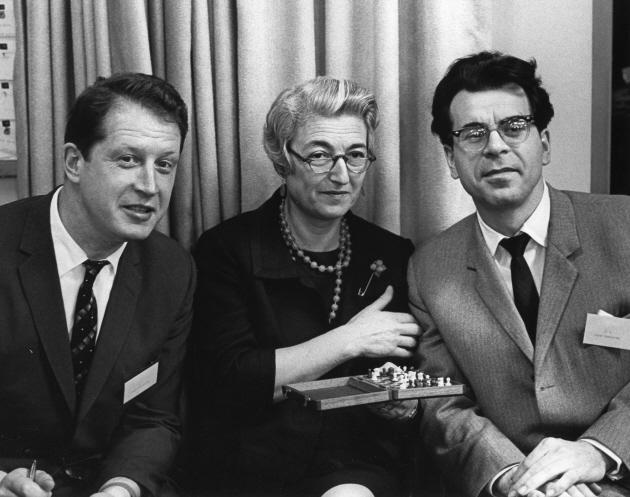
The above photograph of Yuri Averbakh, Jacqueline Piatigorsky and Pal Benko has been forwarded by John Donaldson (Berkeley, CA, USA).
(8051)
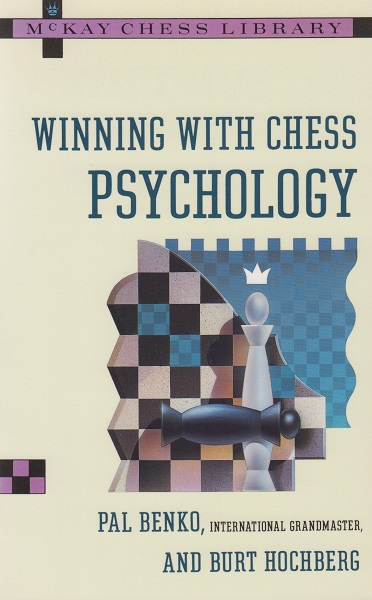
From page 209 of Winning with Chess Psychology by Pal Benko and Burt Hochberg (New York, 1991):
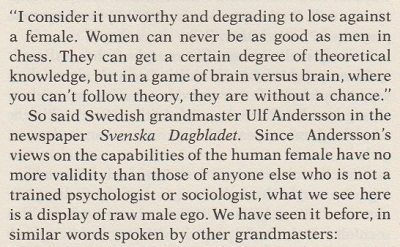
Wanted: the full text of, and exact source for, Andersson’s remarks in Svenska Dagbladet. His interview with the publication (early September 1989) was referred to in an editorial, ‘Kvinnligt och manligt’, on page 313 of the October 1989 Tidskrift för Schack.
There was a reprise of the phrase ‘unworthy and degrading’ on page 215 of Winning with Chess Psychology, when Benko was discussing Lone Pine, 1977, in which Nona Gaprindashvili was a participant:
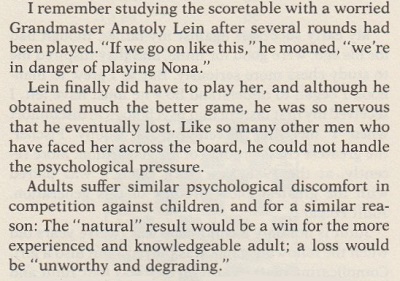
That passage was used on page 163 of Players and Pawns by Gary Alan Fine (Chicago, 2015):
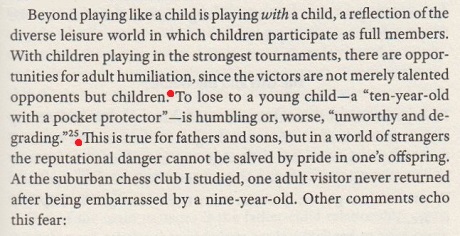
The endnote on page 254:
And so alleged words by Andersson about losing to women became a generality about losing to children.
(8683)
A photograph taken during the Candidates’ tournament in Yugoslavia, 1959:
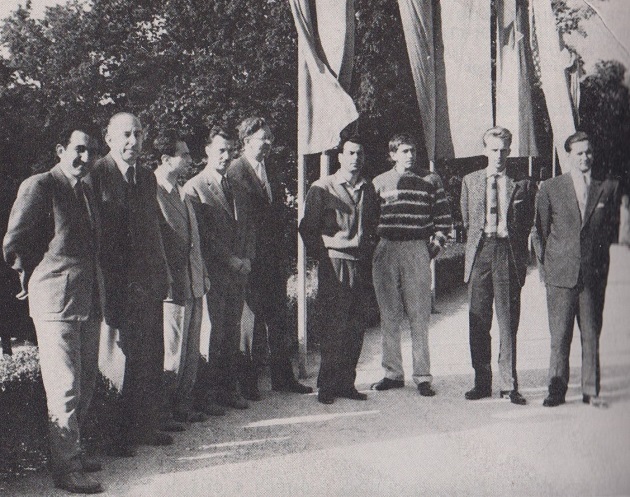
From left to right: Petrosian, Golombek (chief arbiter), Tal, Gligorić, Smyslov, Benko, Fischer, Ólafsson, Keres.
Source: Chess Review, December 1959, page 360. A less clear copy of the picture is opposite the imprint page of Kandidatenturnier für Schachweltmeisterschaft by S. Gligorić and V. Ragozin (Belgrade, 1960) with the caption ‘Alle Spieler mit grossen Hoffnungen: Vor dem Turnierbeginn in Bled’.
(10332)
On page 157 of Winning with Chess Psychology by Pal Benko and Burt Hochberg (New York, 1991) Benko wrote:
‘About a year after Lasker’s death, Capablanca died, and a book appeared in Hungary containing 300 of his games, many of them annotated by grandmasters. Although Lasker remained my idol, Capablanca’s games taught me technique and enabled me, at age 17, to become a master.’
On page 4 of Pal Benko My Life, Games and Compositions by P. Benko and J. Silman (Los Angeles, 2003) Benko recalled:
‘I avidly studied a book of Capablanca’s 350 best games (this was my first chess book and the Cuban quickly became my chess hero).’
The book was by Ferenc Chalupetzky and László Tóth (Kecskemét, 1943). It had 319 numbered games and some fragments.
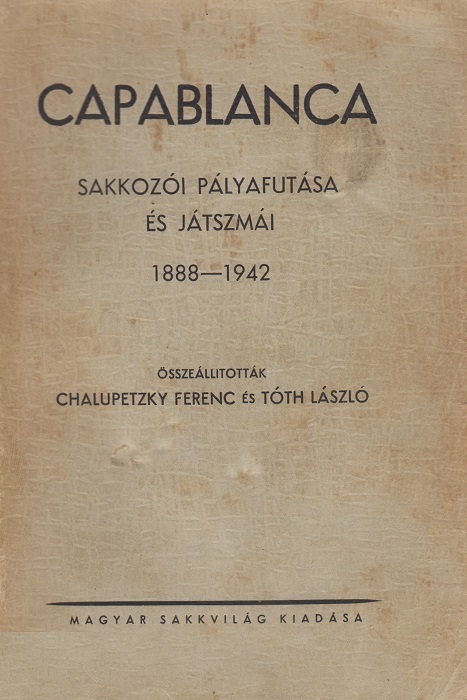
(11221)
From page 288 of My 60 Memorable Games by Bobby Fischer (New York, 1969), in game 46:
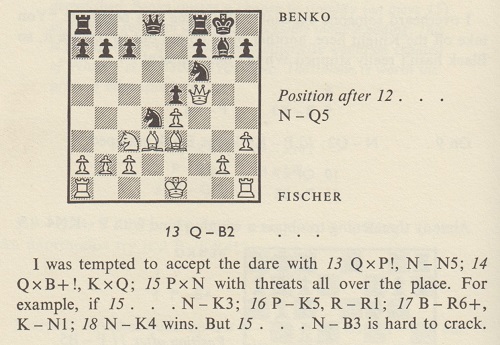
In a report on a simultaneous exhibition by Fischer in Toronto on 27 February 1964, Wayne D. Komer noted on page 223 of CHESS, April 1964 that Fischer first gave a 45-minute talk on that game against Benko (1963-64 US Championship):
‘He drew a large chuckle from the crowd when he said that after studying the board [in the diagrammed position] he decided not to play 13 QxKP and then sacrifice the queen for the bishop after 13...N-N5 (14 QxBch KxQ 15 PxN) because he thought this game would then detract from his (brilliant) victory over Robert Byrne in round three when it came time for the judges to award the brilliancy prize.’
The full article has been reproduced in A Legend On the Road by John Donaldson (Seattle, 1994 and Milford, 2005). See pages 20-21 and 34 respectively.
(11222)
Regarding the shortest possible game ending with mate through an en passant capture, a topic raised in C.N. 179, Michael McDowell (Newtownards, Northern Ireland) gave the following in C.N. 221: 1 b3 h6 2 Bb2 f5 3 e4 Kf7 4 exf5 Qe8 5 Qg4 g5 6 fxg6 mate.
That was in 1982. From Larry Evans’ reply to a reader on page 20 of the April 1993 Chess Life:

In C.N. 254 (late 1982) Philipp Mottet (Zuchwil, Switzerland) submitted 1 e4 e5 2 Qh5 d6 3 g4 Nc6 4 Bh3 Kd7 5 g5+ f5 6 gxf6 mate. However, the task of constructing the shortest game with discovered mate by means of an en passant capture had already been resolved by Pal Benko.
Page 31 of the March 1982 Chess Life:
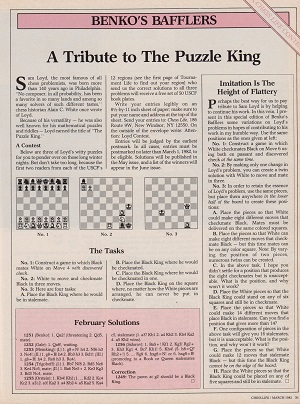
Discussing Sam Loyd, Benko offered this addition:
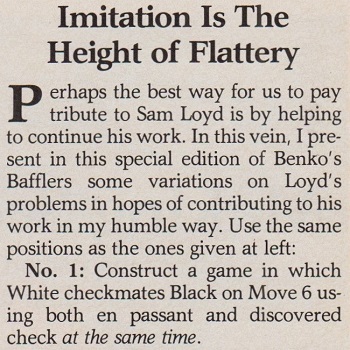
The solution was on page 46 of the April 1982 Chess Life: 1 e4 e5 2 Qh5 Nc6 3 g4 d6 4 Bh3 Kd7 5 g5+ f5 6 gxf6 mate.
From page 654 of Pal Benko My Life, Games and Compositions by P. Benko and J. Silman (Los Angeles, 2003):
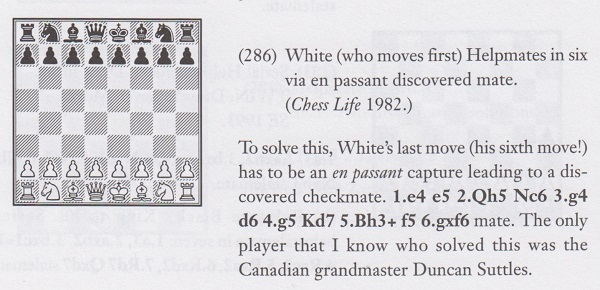
A number of webpages give the source of Benko’s composed game as ‘Chess Life & Review, 1976’, as did page 30 of Chess Braintwisters by Burt Hochberg (New York, 1999). However, C.N. 333 pointed out that the puzzle had been shown by Leonard Barden in a Christmas quiz on page 11 of the Guardian, 24 December 1975. (Page 14 of the 12 January 1976 edition announced that the first correct entry opened was from John Littlewood.)
The earliest appearance of the Benko puzzle that we can cite is on page 675 of the October 1975 Chess Life & Review, in an article by Hochberg:
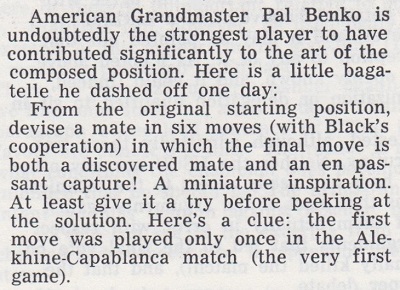
The solution (printed upside-down on the same page):
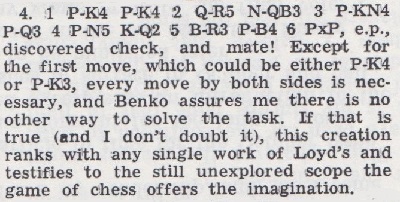
(11375)
Michael McDowell (Westcliff-on-sea, England) notes that his invented game concluding with an en passant capture (C.N. 221) was anticipated by C.D. Locock according to page 6 of Synthetic Games by G.P. Jelliss (1998). However, the Locock game appeared not in the January 1921 Chess Amateur (‘CDL CA i 1921’) but on page 152 of the February 1922 Chess Amateur, in T.R. Dawson’s ‘Fairy Chess’ column.
(11382)
In his article ‘The Romantic Art in Chess’ on pages 15-16 of the January 1969 Chess Life, Pal Benko discussed The Immortal Game and The Immortal Chess Problem. Regarding the composition by K. Bayer (‘C. Meyer’) he wrote:
‘This problem excited its composer’s contemporaries no doubt because of the sheer quantity of material sacrificed in order to give mate with the last pawn. In a way it resembles the classical tragedy: almost all the “actors” die before the play is over. It is certainly an extraordinary idea, but, for today’s taste, “how” is of greater significance than “how much”.’
(11423)
Benko’s articles were not always thoroughly checked, as was pointed out in C.N. 2225 (full text below):
The US magazine Chess Life has a few columnists who write about, or touch on, chess history, though with little perceptible concern about accuracy. For example, Pal Benko’s column in the December 1998 issue discusses three old positions:
a) ‘Pirc-Flohr 1923’. The correct date is 1929. (The position arose in that year’s Rogaska Slatina tournament – see C.N. 2161, on pages 37-38 of Kings, Commoners and Knaves.)
b) ‘Alekhine-Taylor (1936)’. Mr Benko admits that he does not own Alekhine’s Nottingham, 1936 tournament book, which doubtless helps explain why Tylor’s name is twice spelt ‘Taylor’.
c) Sämisch v Nimzowitsch, Copenhagen, 1923. A reader raises the subject of the ‘Immortal Zugzwang Game’ and quotes a definition of Zugzwang by ‘a most knowledgeable authority’, Golombek. In reality, the definition was written by Wolfgang Heidenfeld. Golombek was on record as calling the Nimzowitsch victory ‘the finest possible example of Zugzwang’, whereas Heidenfeld’s view was that the game did not feature Zugzwang at all.
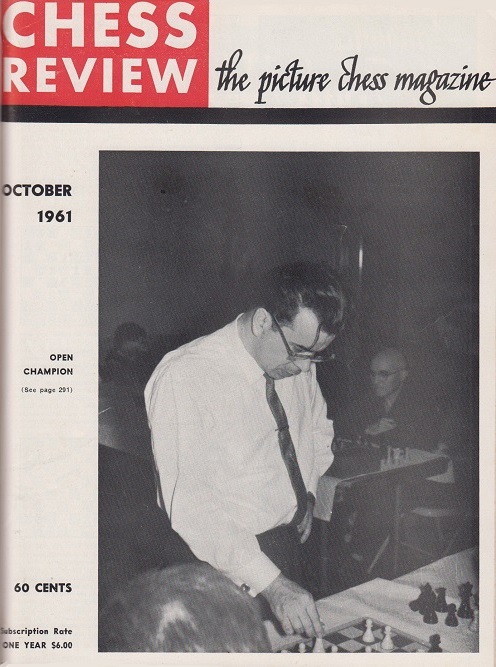
The recent death of Pal Benko prompts us to recall the exceptional quality of Pal Benko My Life, Games and Compositions by P. Benko and J. Silman (Los Angeles, 2003). Anyone dipping into it again may care to begin with Silman’s interview with Benko on pages 425-432. It includes this comment on page 426:
‘When I gave my place to Fischer for the Interzonal in Palma de Mallorca in 1970, I was sure Bobby would advance to the Candidates Matches and beat the Russians. My own career was nearing its end, so why shouldn’t I give Fischer a chance to embrace his fate? I never had any doubts about his success, and he didn’t disappoint me.’
In ‘chess literature’ there are many vague claims that Benko was paid to cede his place in the Interzonal tournament (Palma de Mallorca, November-December 1970).
An early reference to money is at the end of an article by Miro Radojčić on pages 368-370 of the July 1970 Chess Life & Review:
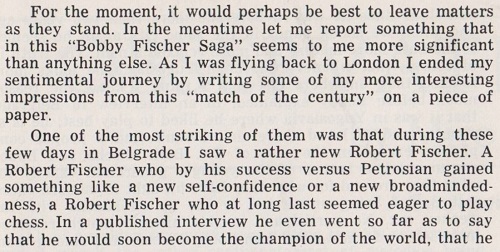
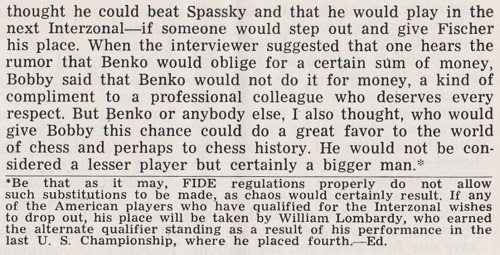
Benko gave the following account on page 439 of the July 1975 issue of the same magazine:
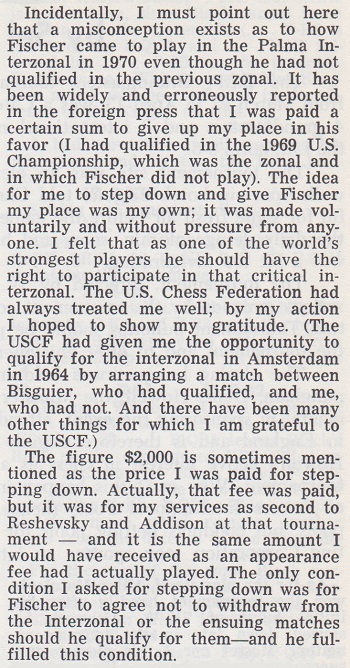
In the ‘Ask the Masters’ column on page 56 of Chess Life, July 1981 Benko reverted to the topic with a brief summary:
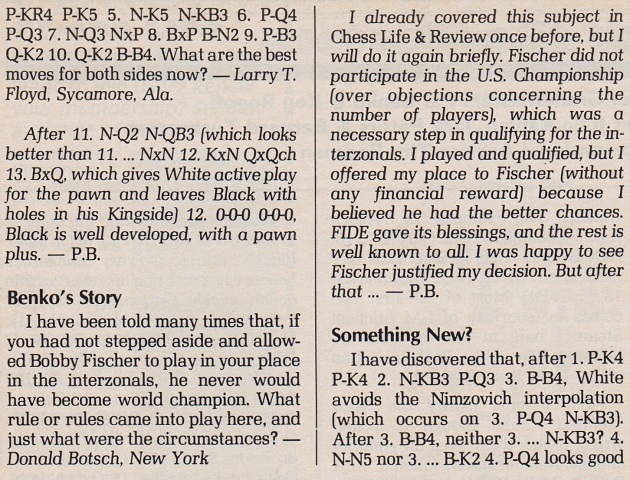
(11458)
John Donaldson (Berkeley, CA, USA) provides this photograph:
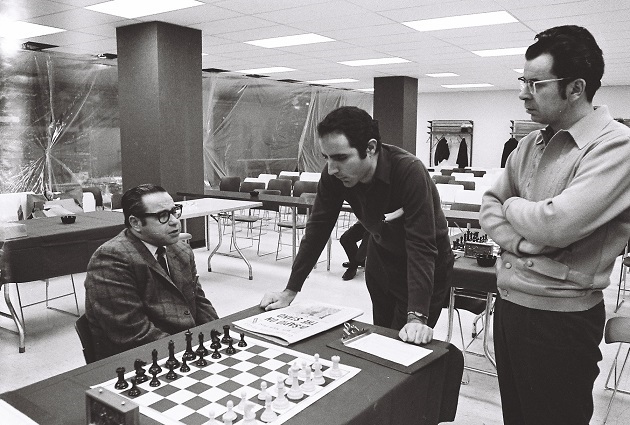
John Donaldson: ‘Arthur
Bisguier, Anthony Saidy and Pal Benko
(photograph taken by the late Beth Cassidy).’
Although the above photograph is undated, the newspaper headline appears to be ‘De Sapio on the Stand’, i.e. a reference to the trial of Carmine De Sapio in December 1969. That month saw the conclusion of the US Championship in New York, in which Bisguier, Saidy and Benko all participated.
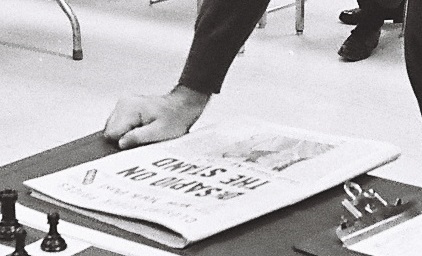
(11579)
The magazine Gens una sumus, edited by Dimitrije Bjelica, first appeared after the 1986 Dubai Olympiad. Issue 2-3 is dated July 1987. The two issues contain a spectacular historical article by D.B. entitled ‘Kings of Chess’ in which the reader is introduced to such greats of the golden era as Blackbern, Dikon, Mongredijen, Grin, Anderson, Berd (Henri Eduard), Blackburn, Zuckertot, Vinaver, Mekenzy, Golmaj, Martines, Bahman, Janevski, Sesil de Vara, Andersen, Kolis, Levental, Harvik, Tarash, Pilsbery, Lloyd, Zueckertot, Charusek, Frenk Marshal, Byrne, Gunsburg, Mizes, Minoti, Li, Kiesericky, Cukertot, Mesona, Marocia, Marozi.
There is less fantasy with the modern masters, although the first issue does have an article by ‘Pol Banko, Granmster (USA)’.
(1695)

Continuing to browse through old correspondence files, we see a letter dated 26 September 1988 from George Stern (Woden, Australia), He enclosed his chess column on page 14 of the Canberra Times, 17 March 1985, featuring ‘a capsule autobiography of Pal Benko, which I recorded when he was in Canberra in 1985’:
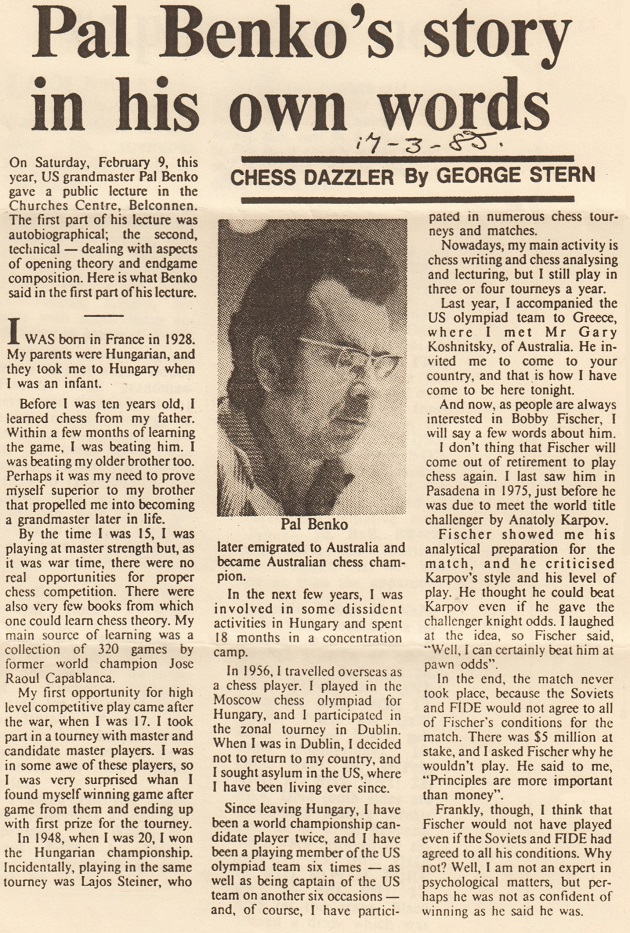
We have shown the column to John Donaldson, who comments:
‘This is an interesting article, albeit with several inaccuracies. It is possible that Benko’s memory betrayed him, but much more likely that the reporter got the details wrong.
It appears to violate Fischer’s dictum that friends not speak about him to the press. Benko was a faithful adherent to this rule, which partly explains why he and Fischer remained friends until the end of Fischer’s life.
The probable explanation for Benko making an exception is that at the time of the lecture he had not been in contact with Fischer since the late 1970s and likely thought he never would be in contact again.
Material which David DeLucia has shared in his books makes it clear that Fischer’s correspondence with Benko and Gligorić stopped around 1978 and did not resume until the early 1990s. Benko in 1985 had no way of knowing that Fischer would reach out to him again.
It is curious that the article mentions 1975 as the time of the last meeting between Benko and Fischer. This is likely wrong as Benko played in the 1978 US Championship held in Pasadena at Ambassador College, which was run by the Worldwide Church of God. The venue was close to where Fischer was living at the time. Kavalek, Lombardy, Zuckerman and Christiansen are all known to have had contact with Fischer during the 1978 US Championship. It is possible that Benko and Fischer did not meet during the event, but it seems much more likely that they did.
The details surrounding Benko’s defecting from Hungary and settling in the United States are also bungled, and it seems hard to believe that he would get them wrong. His last event under the Hungarian flag was not the 1957 Dublin Zonal (held from 12 May to 1 June) but the 1957 Reykjavik Student Olympiad (11-26 July). It was only after that tournament that he applied for asylum at the US Embassy.
One point that I had not realized until today is how long Benko spent in Iceland – he was still there in October 1957, when he participated in a 12-player round-robin tournament in Reykjavik, finishing second, half a point behind Olafsson, but ahead of Ståhlberg and Pilnik.
Benko’s first event in the United States may well have been his match against Ken Smith at Dallas in 1957 (30 November-18 December) alongside the main event. In the second bulletin for Dallas, 1957 page 2 states: “Paul [sic] Benko, who came to Dallas with the hope of playing in the tournament, has found some competition. He was challenged to a seven-game match by Ken Smith, the only master in the South.” Benko won 5½-1½.
Pal Benko: My Life, Games and Compositions (pages 81-82) mentions that Benko initially planned to defect after the 1957 Dublin Zonal but, upon reflection, preferred to do so in Reykjavik. In between the two events he spent over a month in Luxembourg giving exhibitions.
One suspects that Fischer never saw the Canberra Times article.’
(11831)
To the Chess Notes main page.
To the Archives for other feature articles.
Copyright: Edward Winter. All rights reserved.